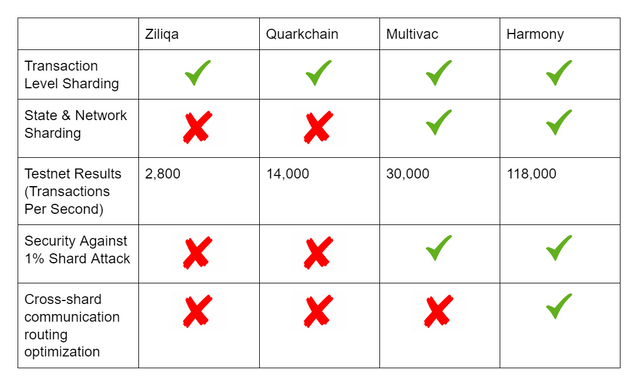Harmony Blockchain!! Harmoniously-built, Open Consensus for 10 Billion Users!
Preamble
Since the birth of the blockchain technology in 2008 by Satoshi; the way we store and manage our money has changed due to the obvious advantages it offers when compared to traditional banking method; especially in key areas such as security and control of funds. However, the technology is yet to gain mainstream adoption due to drawbacks which can be associated to performance issues; some of which have being addressed partly in alternative block chain solutions such as zilliqa; one of the first public block chain to address the issue of scalability by implementing sharding technology along with PoW(Proof of Work) consensus mechanism; leaving its with a partially decentralized block chain framework, thereby compromising security and control in the process1.
However, a trust-based, fast and scalable network can ONLY be built on a fully-decentralized blockchain infrastructure which entails that the present underlying protocol be improved upon in terms of network (node-to-node communication) layer and application (dApps) layer interactions. This has led to modifications in various concepts which are relevant to the performance of the blockchain. One of such concept that has gain reverence in recent times is Sharding. Therefore, sharding simply is the process of dividing large database(host of nodes) into smaller manageable units or into groups of nodes(computers or intelligent devices); technically a group is called Shard.
Sharding was a concept borne out of the need to ensure the blockchain is able to manage huge bills of data in a fast, scalable manner without compromising security and user control; a prominent feature of the present financial framework. Handling large data will inevitably contribute to the slow nature of proprietary blockchain, hence the scalability, making it not feasible for mainstream adoption by various industry.
Some of the urgent problems which needs to be addressed before the block chain can gain wide-spread industry adoption are highlighted below
[1] Performance
Most prominent blockchain frameworks requires atleast two-thirds(2/3) of all participating nodes to reach a consensus before a transaction can be acknowledged; while every node connected to the network must save a copy of the transaction history. The block chain uses complex algorithm to meet such requirements; which means that the process demand huge computional power and resources before a transaction can be sanctioned on the block chain. Therefore, the security-conscious culture of the block chain compromise speed, efficiency and overall scalability of the block chain which are the performance metrics of a good networking framework such as the block chain.
[2] Scalability
Scalability ensures that performance is not affected as more nodes join the network. Scalability in blockchains is based majorly on the consensus protocol which the proprietary blockchain adopts, one of the most common is PBFT(Practical Byzantine Fault Tolerance) which demands that all participating nodes rebroadcast their votes to the network after computation; making the whole process degeneratively slow as more nodes join the network. This makes wide-spread industry adoption almost impregnable. Interesting old concepts are constantly being churned out for new and better propositions every day which means that the blockchain technology is close to the full realization of its potentials with the introduction of FBFT (Full Byzantine Fault tolerance) consensus mechanism, first implemented on Harmony public blockchain.
[3] Complex routing topology and associated high transaction fee
One of the major effects of implementing the PBFT consensus is that it takes longer time for the complex computations to be completed whether the network adopts the PoW or PoS(Proof of Stake) consensus because of its two-layer communication complexity ( expressed graphically as O(N)2) . This means that in both consensus method, the miner is likely to incur much cost in processing a block or transaction which inturns drives transaction fee high for the network.
Some modifications to the PBFT protocol led to the birth of an improved protocol in FBFT to drive linear communication complexity ( expresssed graphically as O(N) ) . Therefore, node can communicate at least 50‰ faster than before using FBFT which yields better dividends for all participants within the ecosystem (users, miners e.t.c) .
Introducing Harmony Blockchain
Harmony Blockchain is a new blockchain solution which aim to realize the dream of a fully-decentralised economy while maintaining scalable yet high performance network. Their goals and vision aligns with the dream of achieving a high-performance network to drive mass blockchain adoption even beyond the native cryptocurrency use case.
Therefore Harmony Block chain takes the highway approach by building a network that doesn't compromise speed over cost or performance over reliability but rather leverage new concepts to provide better solutions. Subsequent sections also reveal why [Harmony blockchain] has obvious advantages and features which can allow it to stand the test of time and in effect position blockchain as a daily tool for commercial and industrial purpose .
Harmony Blockchain Ecosystem Overview
Using Sharding techniques to solve scalability issues
The major problem associated with block chain is inherently node management. For example a full node in the Ethereum network stores the entire state of the blockchain, including account balances, storage, and contract code; which means the network can atleast be only as fast as the individual nodes rather than the sum of its parts. So obviously, as more nodes get added to the network, the loads of computation increases which inevitably increases the transaction fee accruable and the overall speed of the network which is based on the Transaction Per Seconds(TPS).
Harmony addresses this issue by implementing the sharding technique along with Fast-BFT and BFT multi-signature ;to ensure that each shards(group of nodes) is required to carry ONLY a portion of the data that needs computation. This means that a single node doesn't carry the whole burden of the network.
As opposed to blockchain solutions like quarkchain, multivac; Harmony implements state sharding whereby each shard holds a subset of the blockchain state and is able to perform transaction in parallel fashion concurrently.
Adopting a PoS consensus mechanism to manage 1% shard attack
As opposed to conventional blockchains implementing PoW such as bitcoin which requires large resources for attackers to gain control of the network (at least 51% of the nodes); One can say shards are relatively an easy target for attackers. This is arguably a viable reason to avoid a shard blockchain implementing a PoW consensus since attackers can easily concentrate their hash-power to a single shard and gain control over the shard (1% shard attack). It has to be said that PoW implementation helps to prevent Sybil attack.
However, Harmony in its bid to circumvent the 1% shard attack on its network adopts the PoS consensus by ensuring that validators are chosen by random sampling at intervals (called epochs). This technique has two motives
Attackers cannot choose the shard they want to work on.
Attackers cannot know what shard they will work on ahead of time
Cross-Shard communication
As opposed to the option of direct node communication accross shards which will incur more cost. Harmony implements the kamdelia routing mechanism to drive an efficient, reliable cross-sharding communication synchronously between shards.
Harmony Building a trust Network : How It Works!
Let's take a look at what happens if Mr A sends some cryptocurrency(data) to Mr B on a block chain like zilliqa.
- Data gets divided into parts
The data sent gets divided into parts or bit. Henceforth, taking each parts simultaneously, the shard containing the respective node ie holding the blockchain version of each bit of the data becomes active and by working side-by- side, it is able to establish communication and reach a consensus if the data is authentic or not within a short time.
- Verifying authenticity of the data sent via the improved FBFT Protocol
Using the PBFT consensus protocol, one node is elected as the leader validate responsible for creating new blocks while other nodes act as validators and need to rebroadcast their vote to the network majorly for vote counting. However, FBFT consensus differs in the sense that validators are not required to rebroadcast their votes to its members, thanks to a single multi-signature and a commit round; each validator is able to communicate with the leader to establish a consensus. 2/3 quorum of votes is required to reach consensus.
Cross-sharding is also enabled if need be.
To vote : validators need to have voting shares bonded to them. One bonded voting share grants one vote for a validator to cast in the FBFT consensus. And it will stay validated for the bonding period of 7 epochs Validators are randomly permutated via the DRG protocol. Starting at the first first position in the sequence, each validator stays a leader for 40 blocks. A given epoch time processes 16384 blocks and an estimated 5s block interval, ensuring each validator have a chance of becoming a leader
Source : Medium`
- Block is created, transaction completed!
Once the block is generated, Mr B receives the crypto asset sent by Mr A, thereby driving a trust economy for various parties.
Highlighting key innovations and features of Harmony Blockchain
Peer-to-Peer Communication
Highly scalable FBFT (Fast Byzantine Fault Tolerant) consensus using BLS (Boneh-Lynn-Shacham) multi-signatures
Deep sharding with adaptive Proof-of-Stake for strong network security.
Secure distributed randomness generation protocol using VDF (Verifiable Delay Function).
Kademlia routing and erasure encoding for optimal network performance.
Zero-knowledge proof of data sharing to ensure customer's privacy.
Harmony Blockchain in the spotlight
Harmony blockchain provides a robust framework for businesses and industries to reach there full potential. Some ideas that may fast-track the adoption of Harmony blockchain are highlighted below;
¶ Drive A Value Economy
For instance, this is a major sell-off for a marketplace created on the Harmony blockchain infrastructure since the network efficiency is not greatly compromised every time a new node joins the network or a transaction is initiated. Therefore, response to an order can be received within the shortest time without much delay. Thereby, driving the value economy for numerous businesses on the marketplace.
¶ A hub for hosting IoTs
IoTs(Internet of Things) is the next big thing and it seeks to lead the next phase of technology industrial and commercial revolution. And here is another area where Harmony might find some use cases. Imagine the possibility of using your phone to track a car that is not within your geographical location. After all, it appears the local car tracker has limitations; whereas blockchain are ubiquitous by nature. hence, solving the issue of geographical constraint a user might face when using the former.
¶ Designed to support industry-specific apps
Sharding can help dencentralised applications (dApps) access information in a fast, secure and trustless manner. The purpose of building apps is to be able to streamline things that are relevant to the industry. For instance, a network provider may build an app for consumers to easily buy data, subscribe for internet services and so on. Using a dApp will not require the user disclosing personal details which might lead to security breach when private transactions are being conducted on the network..
Other interesting usecases are ad exchanges, credit ratings e.t.c
Harmony Blockchain Governance Model and Tokenomics
Harmony’s open, decentralized network is enabled through the use of the native protocol token — Harmony ONE. The token incentivizes and rewards a variety of participants including developers, validators/stakers, investors, and community members who develop, secure and govern the network. In order to use the network, users pay a small transaction fee denominated in the native Harmony token.
The Harmony token will also function in the following aspects of the protocol:
- For staking, which is necessary to participate in the POS consensus & earn block rewards and transaction fees.
- As payment for transaction fees, gas and storage fees.
- To vote for on-chain governance of the protocol
Reliving the first testnet ever hosted on the Harmony Blockchain - Some Facts About Pangaea
Pangaea was an experimental zone for thousands of people to interact with the Harmony network, test the limitations of the technology and have lots of fun while earning rewards.
Pangaea is created purely for experimental purposes. It will have its own currency for playing and bookkeeping.
Within the first 24 hours the initiative had the following metrics:
138 Nodes up & running already 1283 Signups 77 Countries 356 Keys Downloaded
Third-Party Partnership : Matic
Matic will allow dApps to run complex computation task off chain as a result dApps pay less gas fee and potential slow performance will not affect the overall network
Use Cases
Gaming
Felicity is studying computer engineering at a local university in Nairobi; he loves to study hard but also creates time to catch fun. One of his favorite past time activity is to play the poker game. Soon enough, he was ask to design a project that picks their interest using the latest technology. He decides to stick with the poker game and having read about Harmony Block chain he felt confident more about the prospects of having such a fun game driven on a platform that is fast yet scalable. Apart from the obvious advantages the platform offers, what interest him the most is the chance of being rewarded for doing what he likes.
Soon enough, he decides to create an economy for his game so that other players can play and also get rewarded in the process.
Micropayments
Some task requires the subject to disburse funds in small bits from a large pool to many end users - An example is airdrops. However, this trivial activity can attract a huge waste of time and resources. Harmony Blockchain is robust enough to complete such transfers at minimal costs.
Synopsis
Vs Other Blockchain solutions


